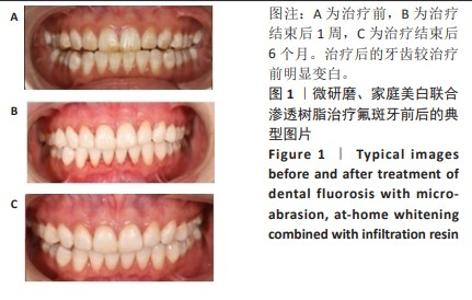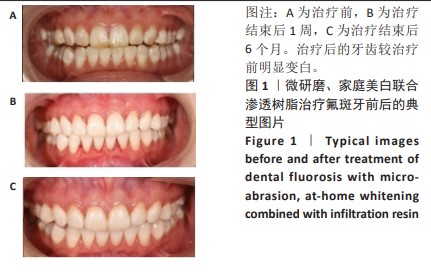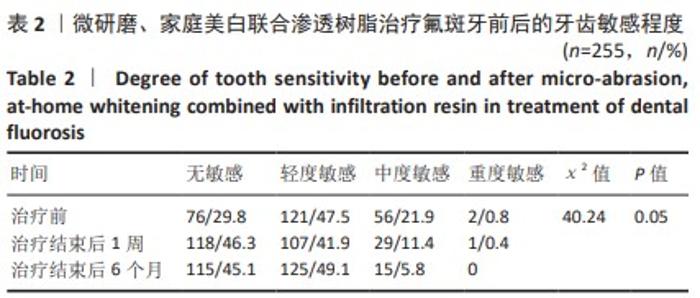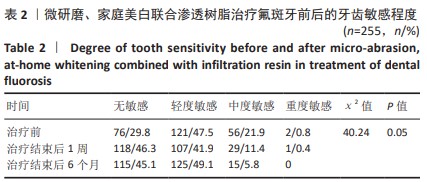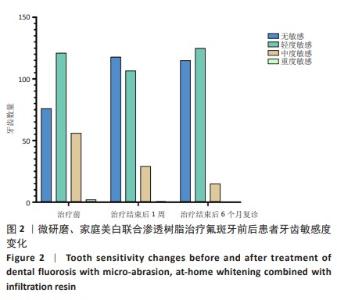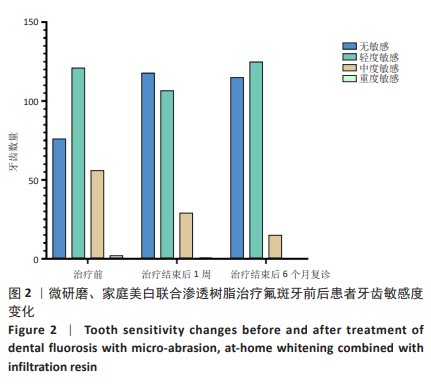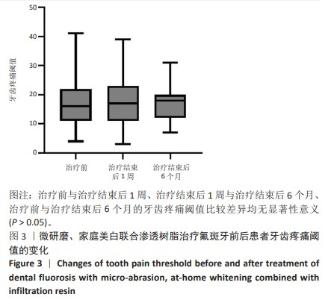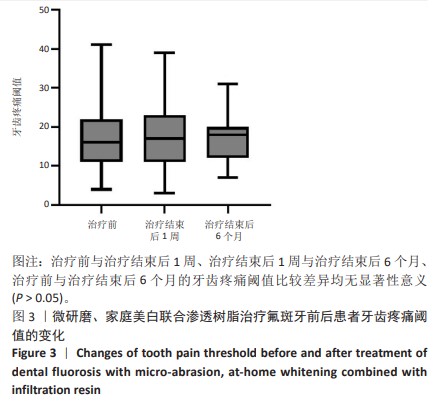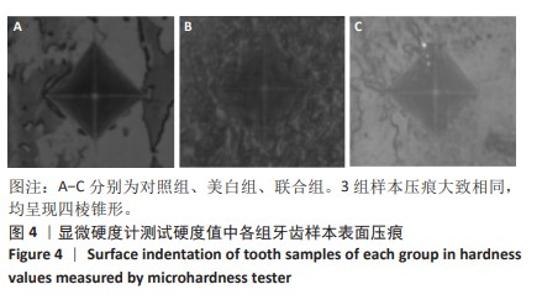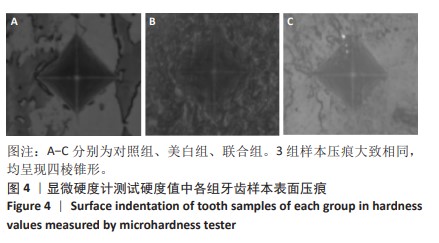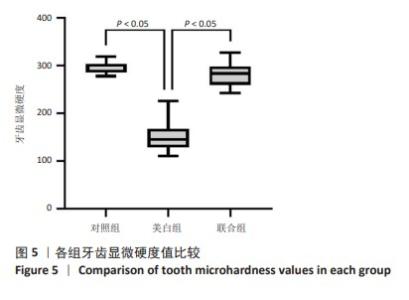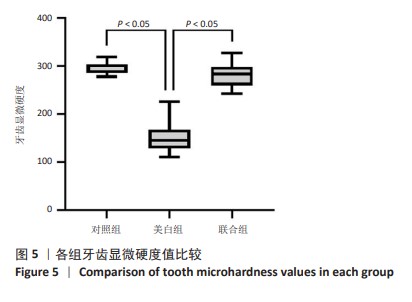Chinese Journal of Tissue Engineering Research ›› 2025, Vol. 29 ›› Issue (4): 686-691.doi: 10.12307/2025.256
Previous Articles Next Articles
Infiltration resin combined with whitening technique on micro-cracked dental fluorosis
Zhang Wenyi1, Yin Zhao2, Zhang Jian3
- 1Department of Prosthodontics, 3Department of Oral and Maxillofacial Surgery, Stomatology Hospital, Tianjin Medical University, Tianjin 300070, China; 2No. 4 People’s Hospital of Hengshui, Hengshui 053000, Hebei Province, China
-
Received:2023-07-07Accepted:2024-01-31Online:2025-02-08Published:2024-05-29 -
Contact:Zhang Wenyi, MD, Associate chief physician, Department of Prosthodontics, Stomatology Hospital, Tianjin Medical University, Tianjin 300070, China -
About author:Yin Zhao, Master, Junior physician, No. 4 People’s Hospital of Hengshui, Hengshui 053000, Hebei Province, China Zhang Wenyi and Yin Zhao contributed equally to this article. -
Supported by:a grant from Stomatology Hospital of Tianjin Medical University Project, No. 2020YKY05 (to ZWY); Tianjin Key Medical Discipline Construction Project, No. TJYXZDXK-038A
CLC Number:
Cite this article
Zhang Wenyi, Yin Zhao, Zhang Jian. Infiltration resin combined with whitening technique on micro-cracked dental fluorosis[J]. Chinese Journal of Tissue Engineering Research, 2025, 29(4): 686-691.
share this article
Add to citation manager EndNote|Reference Manager|ProCite|BibTeX|RefWorks
| [1] ZHANG Y, ZHANG K, MA L, et al. Fluoride induced endoplasmic reticulum stress and calcium overload in ameloblasts. Arch. Oral Biol. 2016;69:95-101. [2] WANG L, ZHU Y, WANG D. High-fluoride acitivates the FasL signalling pathway and leads to damage of ameloblast ultrastructure. Arch Oral Biol. 2016;71:31-37. [3] 范淑玲.“十三五”期间我国地方性氟中毒防制现状[J].环境与职业医学,2020,37(12):1219-1223. [4] 黎昌健,蒙衍强,蒋才武.地氟病在中国大陆的流行现状[J].实用预防医学,2008(4):1295-1298. [5] 崔玉山,刘忠慧,李文凤,等. 2016年天津市饮水型氟中毒防治效果调查研究[J].中国预防医学杂志,2017,18(11):814-818. [6] 刘磊.2021年天津市西青区饮水型地方性氟中毒监测分析[J].中国地方病防治杂志,2021,36(6):559-560. [7] 范淑玲,杨风莹.德州市饮水型氟病区氟斑牙患者心理健康研究[J].心理月刊,2020,15(18):220-221. [8] 张文怡,孙迎春,张健.着色型氟斑牙微创治疗的美学效果观察[J].中华地方病学杂志,2019,38(10):800-805. [9] KAHLER W. The cracked tooth conundrum: terminology, classification, diagnosis, and management. Am J Dent. 2008;21(5):275-282. [10] 中华口腔医学会口腔修复学专业委员会. 牙齿漂白治疗技术指南[J].中华口腔医学杂志,2021,56(12):1191-1196. [11] 王连方.氟斑牙的几种“Dean 氏分类法”浅析[J].地方病通报, 2007,22(1):71-73. [12] KIM JH, EO SH, SHRESTHA R, et al. Association between longitudinal tooth fractures and visual detection methods in diagnosis. J Dent. 2020;101:103466. [13] SNOW S, KIRWAN JR. Visual analogue scales: a source of error. Ann Rheum Dis. 1988;47(6):526. [14] IDON PI, NWAMBA PN, UDOYE CI, et al. Does dental fluorosis affect electric pulp test response and/or optimum probe placement site? Aust Endod J. 2021;47(2):307-313. [15] GOETTEMS ML, FERNANDEZ MDS, DONASSOLLO TA, et al. Impact of tooth bleaching on oral health-related quality of life in adults: A triple-blind randomised clinical trial. J Dent. 2021;105:103564. [16] MARAN BM, MATOS TP, DE CASTRO ADS, et al. In-office bleaching with low/medium vs. high concentrate hydrogen peroxide: A systematic review and meta-analysis. J Dent. 2020;103:103499. [17] DONASSOLLO SH, DONASSOLLO TA, COSER S, et al. Triple-blinded randomized clinical trial comparing efficacy and tooth sensitivity of in-office and at-home bleaching techniques. J Appl Oral Sci. 2021;29: e20200794. [18] MOUNIKA A, MANDAVA J, ROOPESH B, et al. Clinical evaluation of color change and tooth sensitivity with in-office and home bleaching treatments. Indian J Dent Res. 2018;29(4):423-427. [19] WANG Q, MENG Q, MENG J. Minimally invasive esthetic management of dental fluorosis: a case report. J Int Med Res. 2020;48(10): 300060520967538. [20] BOUROUNI S, DRITSAS K, KLOUKOS D, et al. Efficacy of resin infiltration to mask post-orthodontic or non-post-orthodontic white spot lesions or fluorosis - a systematic review and meta-analysis. Clin Oral Investig. 2021;25(8):4711-4719. [21] SHAHROOM NSB, MANI G, RAMAKRISHNAN M. Interventions in management of dental fluorosis, an endemic disease: A systematic review. J Family med Prim. 2019;8(10):3108-3113. [22] PARIS S, MEYER-LUECKEL H, CÖLFEN H, et al. Penetration coefficients of commercially available and experimental composites intended to infiltrate enamel carious lesions. Dent Mater. 2007;23(6):742-748. [23] PARIS S, SCHWENDICKE F, KELTSCH J, et al. Masking of white spot lesions by resin infiltration in vitro. J Dent. 2013;41 Suppl 5:e28-34. [24] GARG I, KUMAR A, KUMAR A. Comparative Evaluation of Esthetic Improvement of Resin Infiltration (RI), In-office Bleaching (B), Enamel Microabrasion (M) and Resin Infiltration with Double Application of Infiltrant (2RI) on Non-pitted Fluorosis Stains: A Randomized Six-month Interventional Study. Int J Paediatr Dent. 2022;15(1):20-34. [25] HILTON TJ, FUNKHOUSER E, FERRACANE JL, et al. Recommended treatment of cracked teeth: Results from the National Dental Practice-Based Research Network. J Prosthet Dent. 2020;123(1):71-78. [26] BARBOSA AFA, LIMA CO, SARMENTO EB, et al. Impact of Minimally Invasive Endodontic Procedures on the Development of Dentinal Microcracks. J Endod. 2022;48(9):1146-1151. [27] ROSEN E, VOLMARK Y, BEITLITUM I, et al. Dental implant placement is a possible risk factor for the development of multiple cracks in non-endodontically treated teeth. Sci Rep. 2020;10(1):8527. [28] HILTON TJ, FUNKHOUSER E, FERRACANE JL, et al. Correlation between symptoms and external characteristics of cracked teeth: Findings from The National Dental Practice-Based Research Network. J Am Dent Assoc. 2017;148(4):246-256. [29] ROCHA RS, SOUZA MY, MEIRELLES LCF, et al. Effectiveness of Home Bleaching Treatment after Resin Infiltrant Application. Oral Health Prev Dent. 2020;18(1):549-554. [30] HEYMANN GC, GRAUER D. A contemporary review of white spot lesions in orthodontics. J Esthet Restor Dent. 2013;25(2):85-95. [31] RICUCCI D, SIQUEIRA JF JR, LOGHIN S, et al. The cracked tooth: histopathologic and histobacteriologic aspects. J Endod. 2015;41(3): 343-352. [32] WU S, LEW HP, CHEN NN. Incidence of Pulpal Complications after Diagnosis of Vital Cracked Teeth. J Endod. 2019;45(5):521-525. [33] PROULX C, DUMAIS Y, BEAUCHAMP G, et al. Reliability of Electric Pulp Test, Cold Pulp Test or Tooth Transillumination to Assess Pulpal Health in Permanent Dog Teeth. J Vet Den. 2022;39(2):133-141. [34] LEE KH, KIM HI, KIM KH, et al. Mineral loss from bovine enamel by a 30% hydrogen peroxide solution. J Oral Rehabil. 2006;33(3):229-233. [35] VILHENA KFB, NOGUEIRA BCL, FAGUNDES NCF, et al. Dental enamel bleached for a prolonged and excessive time: Morphological changes. PLoS One. 2019;14(4):e0214948. [36] EL MELIGY OAES, ALAMOUDI NM, ELDIN IBRAHIM ST, et al. Effect of resin infiltration application on early proximal caries lesions in vitro. J Dent Sci. 2021;16(1):296-303. [37] 张迪,李敏,刘进.渗透树脂对漂白后牙釉质表面结构、显微硬度及颜色的影响[J].中华口腔医学杂志,2022,57(5):509-515. [38] SURMELIOGLU D, YALCIN ED, ORHAN K. Analysis of enamel structure and mineral density after different bleaching protocols using micro-computed tomography. Acta Odontol Scand. 2020;78(8):618-625. [39] MAZILU MOLDOVAN A, POPESCU V, IONESCU CV, et al. Various Aspects Involved in the Study of Tooth Bleaching Procedure: A Questionnaire-Based Study. Int J Environ Res Public Health. 2022;19(7):3977. [40] GASMI BENAHMED A, GASMI A, MENZEL A, et al. A review on natural teeth whitening. J Oral Biosci. 2022;64(1):49-58. [41] LI Z, WU Z, WANG J, et al. Expanding the applications of photodynamic therapy-tooth bleaching. Clin Oral Investig. 2022;26(2):2175-2186. |
| [1] | Li Ruotong, Wu Yuening, Deng Yunyi, Chen Shichao, Lan Xiaorong, Li Shiting, Li Guangwen. Preparation and antibacterial evaluation of nanosilver-reduced graphene oxide/polydopamine/methacrylated gelatin@Gap19 hydrogel [J]. Chinese Journal of Tissue Engineering Research, 2025, 29(34): 7333-7343. |
| [2] | Wang Kaigang, Hao Dongsheng, Ma Pei, Zhou Shuo, Li Ruimin. Comparison of efficacy of different biological scaffolds for pulp regeneration therapy in immature permanent teeth: a Bayesian network meta-analysis [J]. Chinese Journal of Tissue Engineering Research, 2025, 29(34): 7447-7460. |
| [3] | Shi Lijuan, Wei Jian, Zhang Xuan, He Lingxiao, Jiang Xiaoxi, Nie Minhai, Chen Jiana, Liu Xuqian. Vascularization characteristics of tissue-engineered oral mucosa equivalents [J]. Chinese Journal of Tissue Engineering Research, 2025, 29(22): 4748-4760. |
| [4] | Peng Luyao, Gu Yu. Relationship between biological mechanism of selenium and selenium nanoparticles and common oral diseases [J]. Chinese Journal of Tissue Engineering Research, 2025, 29(22): 4813-4822. |
| [5] | Zhao Zengbo, Li Chenxi, Dou Chenlei, Ma Na, Zhou Guanjun. Anti-inflammatory and osteogenic effects of chitosan/sodium glycerophosphate/sodium alginate/leonurine hydrogel [J]. Chinese Journal of Tissue Engineering Research, 2025, 29(4): 678-685. |
| [6] | Wang Yuxue, Zhou Xin, Zheng Junyuan, Zhou Yongqing. Human beta-defensin 3 hydrogel for treatment of periodontitis in rats [J]. Chinese Journal of Tissue Engineering Research, 2024, 28(17): 2690-2695. |
| [7] | Li Zhiyao, Hu Zheng, Li Xuan, Lu Peijun. Effects of enamel adhesives with different components on Porphyromonas gingivalis and Streptococcus mutans [J]. Chinese Journal of Tissue Engineering Research, 2024, 28(3): 329-335. |
| [8] | Xu Yinghua, Liu Jing, You Quan, Wen Zhihao, Gao Lu. Effect of neodymium-doped:yttrium aluminum perovskite laser combined with two kinds of remineralizers on remineralization of early enamel caries [J]. Chinese Journal of Tissue Engineering Research, 2024, 28(3): 360-365. |
| [9] | Shen Yurong, Nai Rentong, Zhao Ling, Liu Feigang, Yin Caoyang, Gu Yuanping, Chen Tieyi. Influence of NIC X-FILE and DENCO Pre-Shaper nickel-titanium instruments on the shaping of simulated curved canals [J]. Chinese Journal of Tissue Engineering Research, 2024, 28(3): 387-391. |
| [10] | He Ruya, Liu Yunling, Nie Minhai, Liu Xuqian. Repairing equivalent injury of oral mucosa with concentrated growth factor fibrin membrane combined with recombinant human epidermal growth factor active protein polypeptide complex [J]. Chinese Journal of Tissue Engineering Research, 2023, 27(12): 1848-1855. |
| [11] | Liu Runyuan, Dong Ming, Han Wenqing, Dong Juhong, Niu Weidong. Application and progress of small extracellular vesicles in periodontal and pulp regeneration [J]. Chinese Journal of Tissue Engineering Research, 2023, 27(1): 83-90. |
| [12] | Huang Jie, Ren Jing, Peng Pairan, Mu Yandong. Treatment of periodontitis in rats with a novel temperature-sensitive gel with immunomodulatory peptide [J]. Chinese Journal of Tissue Engineering Research, 2022, 26(22): 3514-3520. |
| [13] | Yan Qifang, Xie Cuiliu, Yan Guowei. Effect of concentrated growth factor and bioceramic material iRoot BP on survival, proliferation and mineralization of human dental pulp cells in vitro [J]. Chinese Journal of Tissue Engineering Research, 2022, 26(21): 3363-3368. |
| [14] | Dong Zhiheng, Gao Yan, Liu Zhen, Han Xiaoqian. Construction of icariin/polycaprolactone nanofiber membrane and its osteogenic ability in vitro [J]. Chinese Journal of Tissue Engineering Research, 2022, 26(10): 1510-1514. |
| [15] | Yang Sidi, Wang Qian, Xu Nuo, Wang Ronghan, Jin Chuanqi, Lu Ying, Dong Ming. Biodentine enhances the proliferation and differentiation of osteoblasts through upregulating bone morphogenetic protein-2 [J]. Chinese Journal of Tissue Engineering Research, 2022, 26(4): 516-520. |
| Viewed | ||||||
|
Full text |
|
|||||
|
Abstract |
|
|||||
